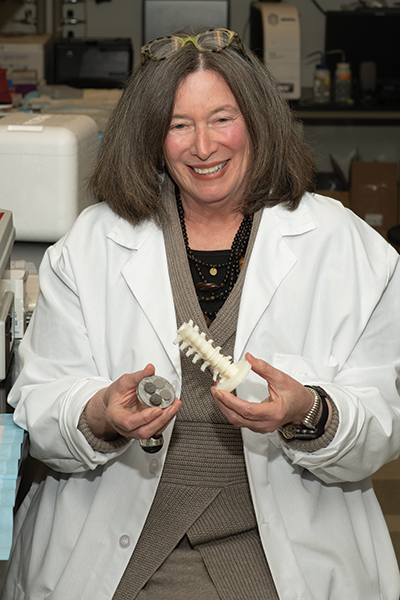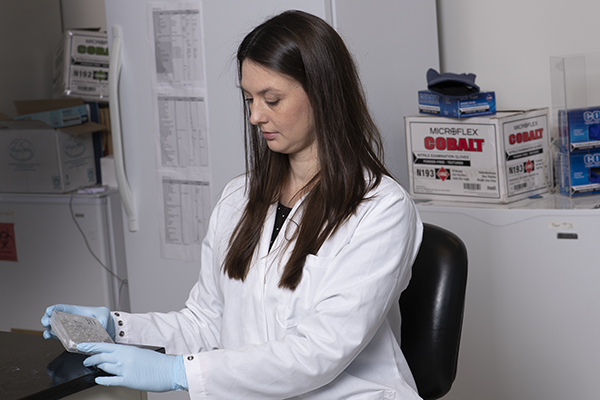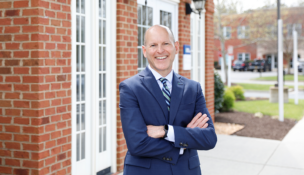A ‘complex, beautiful web’ of support
Medical device developers are thriving in Virginia
Virginia Business //April 29, 2019//
A ‘complex, beautiful web’ of support
Medical device developers are thriving in Virginia
Virginia Business //April 29, 2019//
Kenneth J. Wynne is working in his Richmond laboratory on new technology to protect patients from infections linked to the use of ventilators and urinary catheters.
Medical devices “too often are superhighways for bacteria to go from the skin or from a caretaker’s touch into the body,” says Wynne. WynnVision, his company in the Virginia Bio+Tech Park, is developing ways to reduce infection without the use of antibiotics that can lead to “super-bugs.”
Meanwhile, in the lab of another biotech park startup, Elaine Horn-Ranney is testing a gel used in a product called Perf-Fix. Her company, Tympanogen, plans to market the gel-patch product as a way to repair perforated eardrums without surgery. She co-founded the company while working as a doctoral student at Tulane University. In December, Tympanogen sent samples to the International Space Station to see what other ways the gel may be used to help healing.
But back on Earth, the road between product concept and product launch can be daunting for a new medical device or technology. “You have to be clear-eyed when you decide to do something like this,” says Wynne, a Virginia Commonwealth University professor of chemical and life-science engineering.
The development of a product, he says, involves “a very complex, beautiful web” of support and years of hard work for an idea to be researched, tested and successfully marketed.
31% increase
In Virginia, that effort is showing results, even though the state isn’t top-ranked in the bioscience field.
Analysis released last year found the medical-device subsector of Virginia’s bioscience industry grew four times faster than the national average. In 2016, the commonwealth had 184 medical device and equipment companies, a 31% increase from 2014, according to a biennial report by TEConomy Partners LLC.

A critical issue is the support of investors who can take a startup to the next level, says Boyan, a researcher and entrepreneur who holds many patents. “Virginia has a great startup climate, but it’s missing what I call the translation climate,” she says.
There are exceptions. Boyan points to Kaléo, a Richmond pharmaceutical firm that is nationally known for the opioid overdose treatment Evzio and for autoinjectors for life-threatening allergic reactions.
Other success stories around the state include:
- In Leesburg, K2M Group Holdings Inc., which develops and commercializes spine technologies, was acquired last year by the medical technologies firm Stryker Corp. for $1.4 billion.
- In Charlottesville, University of Virginia startup TypeZero Technologies Inc. is simplifying the lives of people with Type 1 diabetes with smartphone-based artificial pancreas systems that automatically regulate insulin delivery.
- In Norfolk, Embody Inc. builds implants for tendon and ligament repair using regenerative technology to heal soft-tissue injuries.
A growth opportunity?
Jeffrey M. Gallagher, CEO of Virginia Bio, a life-science trade association, sees development of medical devices and technology as a major growth opportunity.
Virginia might not rank among “overall high-power biomedical hubs like Boston and San Francisco,” he notes, but the state exemplifies “a dispersed proliferation of innovation, startups and university research” that has been brought about by changes in science, technology and medicine.
This growth was a major focus of Virginia Bio’s THRiVE 2019 conference scheduled for May 2 in Richmond.
Virginia’s bioscience industry in 2016 employed more than 24,000 people in nearly 1,900 businesses, according to the nationwide analysis by TEConomy, which was conducted for the trade association Biotechnology Innovation Organization.
The industry has grown at a rate more than twice the national average, the report found. While research, testing and medical laboratories accounted for 50% of all Virginia bioscience jobs, employment growth was driven by the surge in medical device and equipment enterprises, the study noted.
In 2016, the subsector employed 2,415 people, with average annual pay of $71,555. Those numbers represent an increase of nearly 12% in employees and a 3.8% rise in pay since 2014.
The direct-effect multiplier puts the total employment impact of the medical device and equipment subsector at 6,245 jobs.
Less risky path?
Gallagher, who will step down as head of Virginia Bio later this year, says one reason for the growth of medical device and technology companies is that they are seen by some investors as having a lower level of risk compared with drug developers.
Generally, creating a device takes less time than developing a drug, which can involve “the most brilliant people in the world who have all the right data,” Gallagher says.
Nonetheless, after years of testing, “ultimately you have to inject [the drug] in the most complex thing we possibly know, the human body, and you just never know what’s going to happen,” he says.
But Boyan says the time needed to develop and test a medical device, especially one used inside the body, should not be underestimated. Two of her patented devices each took about 12 years to reach the market.
People sometimes think a device “looks so small, and it looks so simple, how can it cost that much,” she says. “It’s important to realize the amount of design and manufacturing and testing that goes into it.”
Her work focuses on bone and cartilage biology and musculoskeletal tissue engineering, including dental and spine implants.
“I’ve had a very happy time seeing devices that I’ve participated in the development of make it to the marketplace,” she says. “And one of them is in my back.”
‘A really big tent’
Bioscience covers a diverse mix of technologies, products and research, making the industry a challenge to define, says the TEConomy/BIO report, “Investment, Innovation and Job Creation in a Growing U.S. Bioscience Industry.”
The common thread is the application of knowledge in the life sciences and how living organisms function.
Gallagher says Virginia Bio, which was founded in 1992, brings together a large community of companies working on life-science innovations to address patient needs.
“We purposely have a really big tent,” he says, to share ideas and resources.

“It’s an exciting time, especially in Virginia,” she says. The stepped-up pace around medical innovations helps young companies “because having a stronger community gives a lot more support.”
She expects Food and Drug Administration approval for Perf-Fix will take another two years as Tympanogen focuses on safety studies and methods to streamline the product manufacture.
“There are good and bad things about being involved in a very highly regulated industry,” Horn-Ranney says. “The FDA has a clear-cut description of what needs to be accomplished.”
The regulatory timeline may be much longer than what entrepreneurs encounter in other fields, she says, “but there are guidelines to indicate what pathway you need to be taking and boxes to be checking in order to get approval for the device.”
One step Tympanogen took to shorten its timeline was to begin its research with a gel that already had FDA approval, she says. The Perf-Fix gel acts as a scaffold that allows cells to grow across the perforated eardrum while resorbing the material.
In addition to conducting the science behind the product, the 5-year-old company interviewed surgeons and patients, asking how they would prefer a ruptured eardrum to be treated — in an office or surgical suite?
Surgery now is considered “the gold standard” for treatment, but that approach has changed little since the 1960s, Horn-Ranney says. Her research found surgeons “were hungry for some innovation in that space. So that motivated us to keep working on a solution for them.”
The surveys also revealed the parents of young children also wanted change. Children often suffer eardrum ruptures as the result of infections. “That’s data we can show to investors,” Horn-Ranney says.
Investor support
Investor support is crucial to innovators at every stage of the development of a device or technology, but it is especially crucial at the inception of an idea.
“That earliest-stage funding is the most challenging funding as you’re still trying to prove out your concept,” says Carrie Roth, president and CEO of the VA Bio+Tech Park and of Activation Capital, a nonprofit that provides mentoring resources as well as direct investment to strengthen the entrepreneurial ecosystem in Central Virginia. “It’s the riskiest but the highest reward.”
The Virginia Bio+Tech Park is seeking a new president and CEO to lead its strategic planning and outreach as well as Activation Capital, a nonprofit tied to the park. Roth will remain on staff and move into a chief operating officer role, according to a Richmond Times-Dispatch report. Roth has been president and CEO since 2013.
Entrepreneurs rely on funding help from federal programs, such as the National Institutes of Health and the National Science Foundation, as well as state and regional sources.
Examples include:
- The Virginia Research Investment Committee, which awards grants focused on commercialization of university research that is not limited to bioscience. Last year, Virginia Tech received $1.1 million to match funds for research on a device that will use low-energy electric fields to treat brain tumors.
- Virginia Catalyst, formerly known as Virginia Biosciences Health Research Corp., which promotes health-related collaborations among state research universities and industry.
- The Center for Innovative Technology, which awards GAP Funds as seed-stage equity investments in Virginia-based technology, clean-tech and life-science companies. Tympanogen and TypeZero are among beneficiaries of early seed funding. Embody, which was funded by the Defense Advanced Research Projects Agency to develop treatment for tendon and ligament injuries for the military, last year received GAP funding to develop technology to accelerate healing for sports medicine patients.
Universities also provide funding to help bring research to market. Virginia Commonwealth University in January announced creation of the Health Innovation Consortium, a three-year initiative with more than $7 million in funding that is intended to make the region a hub for the development of new health-care technology, says Nicole Monk, director of VCU Ventures.
While VCU Ventures supports startup activity in the university, the consortium will support collaboration beyond VCU and focus solely on health care, she says.
VCU Health will finance operations and support pre-seed and seed funds. The medical center also will serve as the “testing bed” to help an innovator determine “am I solving a problem worth solving?” Monk says.
Other universities have similar programs, such as the University of Virginia’s affiliation with the Wallace H. Coulter Foundation Translational Partnership Program in Biomedical Engineering. The U.Va. partnership, the only Coulter program in the state, each year awards about $700,000 to six to eight translational research projects.
“They’re each so unique,” says David Chen, director of the U.Va. Coulter program. But the goal is the same — “science serving humanity and really helping move the needle of care.”
The grants help with “the really risky, first money in,” he says.
One Coulter beneficiary is Rivanna Medical, a Charlottesville-based company that produces an ultrasound guidance device designed to improve the success of epidural and spinal anesthesia.
Academic role
The TEConomy study underscores the importance of academic involvement in bioscience research.
In fiscal year 2016, Virginia research universities contributed $736.6 million to bioscience-related R&D in the state, more than half the total expenditures, according to the report. Another $377 million came from the National Institutes of Health in fiscal 2017, with bioscience venture capital investments totaling just over $305 million from 2014-17.
In a separate analysis for the State Council of Higher Education for Virginia and the Virginia Research Investment Committee last year, TEConomy found that, since the 2007-09 recession, the state’s research assets have underperformed in comparison with other states.
That study, which was broader than the biosciences report, highlighted the need for improving the state’s “innovation ecosystem” and bridging gaps in collaboration between university researchers and Virginia-based entrepreneurs.
According to the report, venture capital from 2010 to 2016 was flat in Virginia while rising nationally. And for overall research funding across industry, federal labs and universities, Virginia’s total fell by 6.3%, or nearly $500 million, from 2010 to 2015, while nationally total R&D activity increased 14.5% during the same time.
The report pointed to the life sciences as one of four strategic growth opportunities for Virginia, along with cyber and cybersecurity, integrated networking and data analytics, and “system of systems” engineering.
“Life sciences development in Virginia is still very much being defined through the commercialization of university research and the collaborations unfolding between academic medical centers and Virginia’s major hospital systems,” the TEConomy report says.
While the upside is significant, the report adds, “life sciences development is a marathon given the longtime horizons for new product development and one that must have sustained investment to succeed.”

















